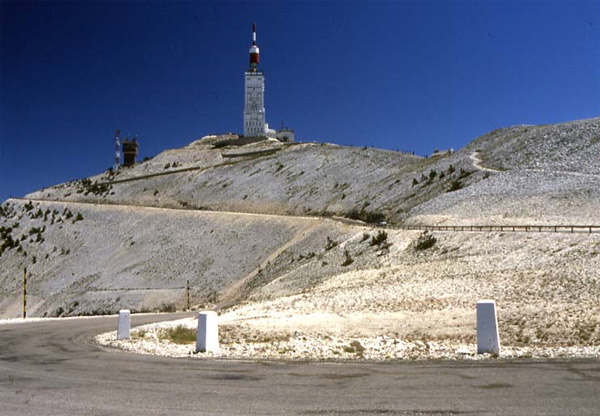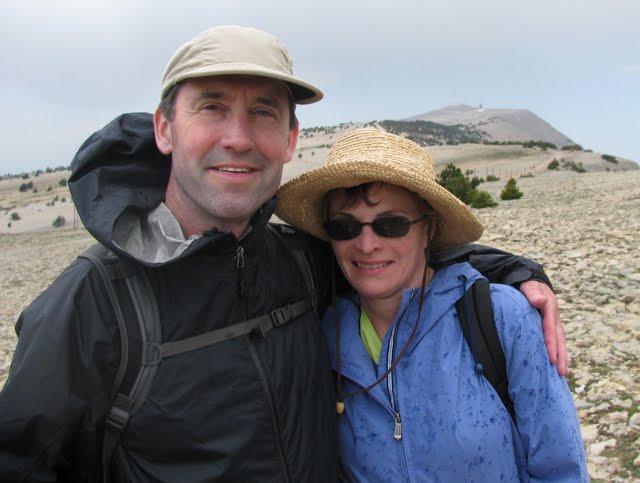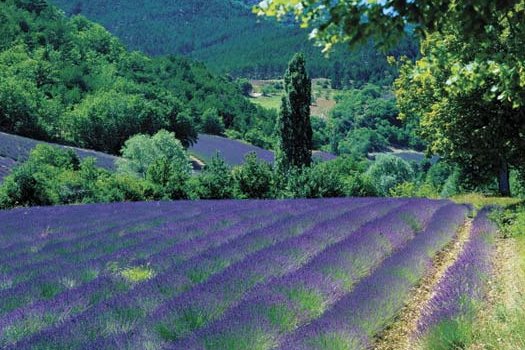In the Footsteps of Petrarch
Nonfiction
Nick O’Connell

Mont Ventoux under clear skies, a rare occurence.
I
t looked like an artillery barrage. Black clouds boiled around Mont Ventoux, the highest peak in Provence. Thunder boomed and lightning flashed beneath the clouds, as if Zeus himself were hurling thunderbolts on those reckless enough to approach.
I watched the display for a week in early June, hoping for a break in the weather so I could attempt the summit. At 6,273 feet, Mont Ventoux is not especially high or difficult, but as the first alpine peak ever attempted, it represents an attractive objective for any hiker, scrambler or climber. In the 14th century, Francesco Petrarch, one of the fathers of the Renaissance, climbed it not for practical or religious reasons, but simply because it was there, thus inventing the modern sport of mountaineering.
As an avid climber having notched peaks in Europe, North America and the Himalayas, I hoped to imbibe some of Petrarch’s spirit by attempting it. After eating and drinking my way through Provence as part of The Writer’s Workshop’s annual Travel, Food and Wine Writing class, my body craved physical exertion and pristine alpine air.
Since Ventoux acts like a magnet for bad weather heading south from the Alps, I hoped the route from Verdolier to the south might escape the worst storms and Mistral winds that hammer the summit from the north, some having been clocked up to 200 miles an hour. At 12 miles round trip and 4000 feet of elevation gain, it promised to be a worthy day trip—if the weather cooperated.
Like Petrarch, I sought suitable companions for the journey. My wife, Lisa, a lifelong runner, was game to give it a try. We also invited Christopher Breunig, a class participant and experienced hiker with a dry sense of humor, always an asset on any adventure.
After winding our way along the back roads south of the peak, we parked under a plane tree in Verdolier, a lovely hamlet of stone buildings and pastures 40 miles east of Avignon in the heart of Provence, a landscape of vineyards, lavender fields and villages seemingly lost to time, a glimpse of what the French like to call La France profonde.
The trail rose steeply above the lavender fields. We passed wild boxwood, thyme, oregano, and rosemary, the air smelling like a spice cabinet. I quickly entered into the rhythm of walking, enjoying the clicking sounds of the trekking poles as we ascended switchbacks through a grove of pines, the needles sharp enough to keep away the roving sanglier or wild pigs.
The sky was blue and windless. No Mistral today, at least so far. As we climbed higher, the pines gave way to scrub oak covered with mistletoe. “I’d kiss you but I’m too sweaty,” Lisa said.
“Thanks,” I said, glad she seemed to be enjoying the trip.
The scrub oak ended near a meadow with a path leading to Jas de Forêt, a small stone hut set in the middle of a cow pasture. Inside, smoke curled from the fireplace. Dozens of empty wine bottles lined the mantle. Someone had scrawled “Mont Fuck” on the wall. This room had stories to tell.
The trail meandered through pines trees, with long congo lines of caterpillars lying along the road. The caterpillars had failed on their quest to reach the promised land of the pine trees, but they kept going, seemingly oblivious to their fate. A cautionary tale?
“They’ve gone to Jesus,” Christopher said.
“Just like the Donner Party,” I said. “I bet the pine trees are glad.”
At a crossroads, I consulted a map and guidebook. Where to now?
A Suzuki 4-wheel-drive pulled up next to us. “Where are you from?” asked a gray-haired man in overalls. He spoke French with a heavy Provençal accent.
“We’re from the U.S,” I replied in French.
“Did you walk from there?” he grinned, using his fingers to mimic walking.
“No.” I laughed. “Do you know how to get to the Belvedere?”
“That way,” he said pointing straight. “Au-revoir!”
The car sped off in a cloud of dust. We kept walking, thankful for his help.
When we reached Belvedere, a campground set in a grove of alpine fir trees, we found a picnic table and spread out a fantastic lunch. I cut slices from an immense hunk of brown peasant bread and layered on ham and Corsican sheep cheese. We washed it all down with a small bottle of Côtes du Rhône.
Everyone seemed to be in a good mood, which pleased me. As the most experienced hiker in the group, I wanted to make sure that everyone stayed on track and got to the top.

Nick O'Connell and Lisa Sowder on the way to the summit. Photo by Christopher Breunig.
After lunch, we kept walking, trekking poles clicking along the stony track, which zigzagged upward. The trail passed through beech forests, deep green, soothing and noisy with birdsong. It started to rain, but we kept going.
The rain kept coming. I put on my rain shell as did Lisa and Christopher. No one seemed fazed by the weather.
The trail wound through a high plateau of wind-blasted pine trees, boulders and wide-open views of the rocky summit, crowned by a radio tower. Black clouds gathered around the top. Thunder echoed in the distance. We splashed through hail on the trail. A sign of what lay ahead?
Strings of hikers passed us coming down. They looked cold, soaked and tired.
We kept going, hoping the storm would pass. Dark clouds swept down from the north. Thunder exploded as if the sky was trying to rip itself apart.
We passed a long line of orange poles marking the path to the summit. The poles buzzed and hummed with electricity. The smell of ozone filled the air. My senses went on high alert.
We hurried up a narrow winding track amid boulders, eager to get to the top. Lisa raced ahead while I kept a steady pace with Christopher a short distance behind.
The wind gusted furiously at the Col des Tempêtes, or tempests, but it didn’t knock us over. I kept trudging, leaning into the wind. The trail paralleled the road. Dozens of cyclists pedaled upward--teeth gritted and steely with determination.
The clouds parted as we reached the summit. I hugged Lisa and high-fived Christopher. We made it!
The summit was overrun with men with low body fat, “beef jerky,” as Christopher called them, most looking to be 50 or 60. They wore pink spandex decorated with the names of their cycling clubs. They hugged each other and raised their fists in triumph, just like Lance in the Tour de France.
After tagging the summit, we headed to the café. Pushing open the door, we found a bar full of hikers.
“Bonjour!” said the waitress, leading us to a table.
We sat down and peeled off our rain parkas. The walls displayed trophy heads of elk, ibex, deer, sanglier, and a ferocious-looking rabbit.
The waitress brought a plate of bread and cheese and a carafe of rosé. “Bon Appetit,” she said.
We raised a glass in toast to our accomplishment.
“Isn’t this a little piece of hell up here?” Lisa asked.
“Yes,” I said. ‘I don’t think Petrarch had rosé to drink at the top.”
Outside, the storm intensified. Rain pelted the windows of the café. Thunder boomed. Lightning crashed. The lights flickered. Then went out. People laughed and chattered in the gloom. The rosé and cheese tasted that much better.
The carafe disappeared quickly, but I didn’t order another. We still had a six-mile walk back to the car. As we paid our bill, the storm subsided.
The walk down was stunning, with wide open views over the wooded lower slopes of Mont Ventoux and the wild, rolling countryside of Provence, a view not much changed since the time of Petrarch.
“And men go to admire the high mountains, the vast floods of the sea, the huge streams of the rivers, the circumference of the ocean and the revolutions of the stars, and desert themselves,” said Petrarch, quoting St. Augustine’s Confessions.
But our trip seemed less like an escape from the self than a rediscovery of it, for unlike Petrarch’s age, we spend too much time in our heads, too much time e-mailing, texting, surfing the web, immersed in a virtual world of data, which often seems more real than the physical world itself. We need the stimulus of wild places like Mont Ventoux to remind us that we are not simply processors of data, but physical human beings who need fresh air and exercise to maintain a sense of sanity.
As we descended, I relished the mental clarity that came from physical exertion. The rain had washed the dust and pollen from the air. Every bend in the trail revealed fresh and unobstructed views across Provence--the cypress trees, the lavender fields, the clusters of buildings around Sault, a small town across the valley unmentioned in any guidebook. I hadn’t noticed before, but now it shimmered in the distance, as compact, vivid, and richly-hued as a watercolor by Cézanne.

TRAVEL, FOOD AND WINE WRITING CLASS - VAISON LA ROMAINE, FRANCE - MAY 20 - 26
THE COURSE - Provence conjures visions of sun, rows of vineyards, groves of cherry trees, fields of purple lavender--a dazzling feast for the senses. The French call it Le Sud, a term that expresses its languor, warmth and rustic charm, the essence of joie de vivre.
The landscape has inspired great writers and artists over the centuries: Van Gogh painted his famous The Starry Night in Arles; Paul Cezanne brilliantly rendered the colors of the landscape in his L’Estaque; Marcel Pagnol wrote The Glory of my Father, a magical memoir of his youth in Provence; English expatriate Peter Mayle highlighted the humor of provincial life in A Year in Provence and many other books.
.
This 2012 Travel, Food and Wine writing class will allow you to experience the richness of Provence and write your version of it. We will visit the region’s best wineries and restaurants, tour its famous monuments, and learn the art and craft of putting all of these experiences down on the page. The class is an intensive seminar in Travel, Food and Wine writing and a fantastic experience to boot.
Travel writing, Food writing and Wine writing are some of the most appealing genres of nonfiction, calling on all of an author's skills—dramatic scenes, character sketches, concrete detail, point of view, scene by scene construction—to compose compelling, engaging travel narratives. This six-day intensive travel writing class will introduce you to essential techniques of travel, food and wine writing and give you expert, insider advice about how to submit and publish finished travel stories.
The six-day travel writing class will take place in Vaison la Romaine, France, one of the most beautiful medieval hill towns in Provence, and a center of the region's cultural and epicurian life since Roman times. The cost will be $2,600 per person, including accommodations and most meals. (Single supplement, $500 per person) Plane fare, transit to and from Vaison la Romaine and some meals extra. For more: http://www.thewritersworkshop.net/travel.htm.
Nicholas O'Connell is the publisher of The Writer's Workshop Review. He travels to France frequently, often as part of his Travel, Food and Wine Writing Class. (www.thewritersworkshop.net/travel)
